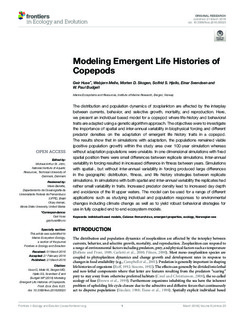| dc.contributor.author | Huse, Geir | |
| dc.contributor.author | Melle, Webjørn Raunsgård | |
| dc.contributor.author | Skogen, Morten D. | |
| dc.contributor.author | Hjøllo, Solfrid Sætre | |
| dc.contributor.author | Svendsen, Einar | |
| dc.contributor.author | Budgell, William Paul | |
| dc.date.accessioned | 2018-09-27T13:28:38Z | |
| dc.date.available | 2018-09-27T13:28:38Z | |
| dc.date.created | 2018-09-06T12:33:26Z | |
| dc.date.issued | 2018 | |
| dc.identifier.citation | Frontiers in Ecology and Evolution. 2018, 6 . | nb_NO |
| dc.identifier.issn | 2296-701X | |
| dc.identifier.uri | http://hdl.handle.net/11250/2565082 | |
| dc.description.abstract | The distribution and population dynamics of zooplankton are affected by the interplay between currents, behavior, and selective growth, mortality, and reproduction. Here, we present an individual based model for a copepod where life-history and behavioral traits are adapted using a genetic algorithm approach. The objectives were to investigate the importance of spatial and inter-annual variability in biophysical forcing and different predator densities on the adaptation of emergent life history traits in a copepod. The results show that in simulations with adaptation, the populations remained viable (positive population growth) within the study area over 100-year simulation whereas without adaptation populations were unviable. In one dimensional simulations with fixed spatial position there were small differences between replicate simulations. Inter-annual variability in forcing resulted in increased difference in fitness between years. Simulations with spatial-, but without inter-annual variability in forcing produced large differences in the geographic distribution, fitness, and life history strategies between replicate simulations. In simulations with both spatial and inter-annual variability the replicates had rather small variability in traits. Increased predator density lead to increased day depth and avoidance of the lit upper waters. The model can be used for a range of different applications such as studying individual and population responses to environmental changes including climate change as well as to yield robust behavioral strategies for use in fully coupled end to end ecosystem models. | nb_NO |
| dc.language.iso | eng | nb_NO |
| dc.title | Modeling emergent life histories of copepods | nb_NO |
| dc.title.alternative | Modeling emergent life histories of copepods | nb_NO |
| dc.type | Journal article | nb_NO |
| dc.type | Peer reviewed | nb_NO |
| dc.description.version | publishedVersion | nb_NO |
| dc.source.pagenumber | 14 | nb_NO |
| dc.source.volume | 6 | nb_NO |
| dc.source.journal | Frontiers in Ecology and Evolution | nb_NO |
| dc.identifier.doi | 10.3389/fevo.2018.00023 | |
| dc.identifier.cristin | 1607262 | |
| dc.relation.project | Norges forskningsråd: 212085 | nb_NO |
| dc.relation.project | Norges forskningsråd: 264993 | nb_NO |
| cristin.unitcode | 7431,0,0,0 | |
| cristin.unitcode | 7431,22,0,0 | |
| cristin.unitcode | 7431,26,0,0 | |
| cristin.unitcode | 7431,1,0,0 | |
| cristin.unitcode | 7431,20,0,0 | |
| cristin.unitname | Havforskningsinstituttet | |
| cristin.unitname | Plankton | |
| cristin.unitname | Økosystemprosesser | |
| cristin.unitname | Ledelse | |
| cristin.unitname | Oseanografi og klima | |
| cristin.ispublished | true | |
| cristin.fulltext | original | |
| cristin.qualitycode | 1 | |
